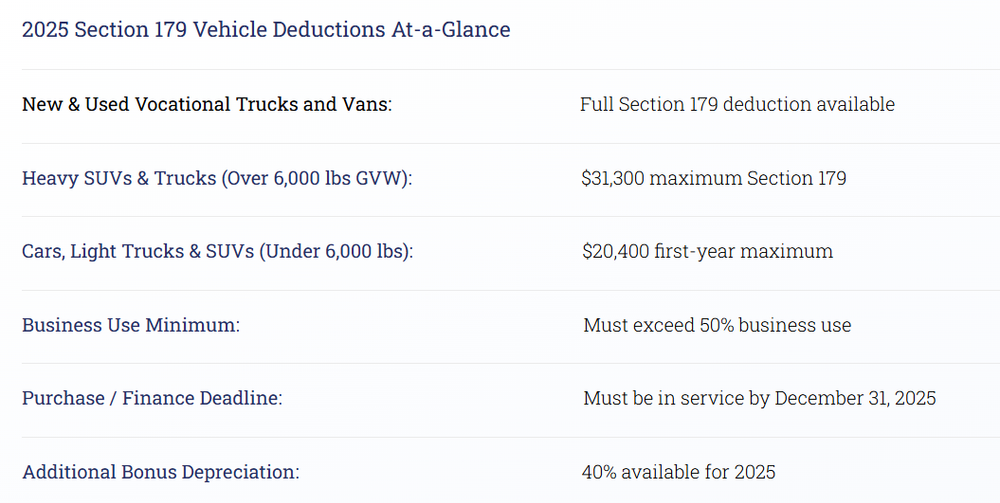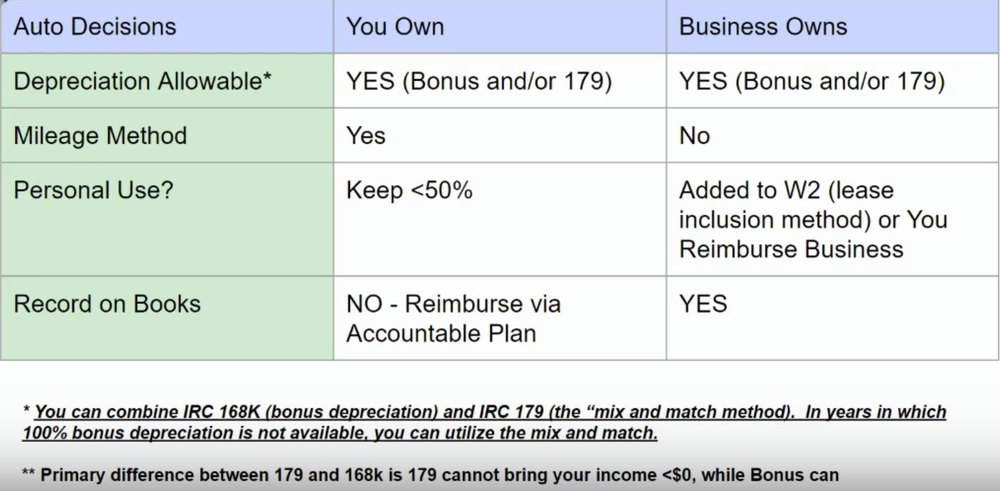Buying a Business Vehicle?
The most common question us accountants get? "How do I write off my business auto?"
Let's cut through the noise and discuss the ways to properly deduct your business auto and the nuances found in the law.
Let's cut through the noise and discuss the ways to properly deduct your business auto and the nuances found in the law.
-
1Understanding Depreciation for Business AutomobilesSo what is depreciation? Depreciation is the process of deducting the cost of a business asset over its useful life.
For automobiles, this means you can recover the expense of purchasing a vehicle by taking annual deductions.
However, because vehicles are often used for both business and personal purposes, and because of their relatively high cost, the IRS has imposed specific rules and limitations...to prevent abuse.
Section 179 lets you "expense" certain items partially or fully but it cannot bring your overall business income below $0 while Bonus Depreciation has annual percentage limits and CAN bring your business income below $0. -
2Stop 1: The Section 179 Deduction (often misunderstood on social media)Section 179 allows businesses to expense the entire cost of qualifying property in the year it is placed in service, rather than spreading the cost over several years.
For business automobiles, Section 179 can be attractive, but there are several important considerations:- Eligibility and Limits:
- Although many business vehicles qualify for the Section 179 deduction, passenger automobiles face annual limits.
- These “luxury auto” limits restrict the amount you can deduct in the first year of service.
- Larger vehicles, such as certain SUVs with a gross vehicle weight rating above 6,000 lbs, may be exempt from these limits.
- SUVs = Capped based on annual limit
- Non SUVs (Trucks) may be exempt from them
- Business Use Requirement:
- To claim Section 179, the vehicle must be used for business purposes more than 50% of the time.
- If your business usage falls below this threshold during the year, you may be required to recapture some or all of the deduction.
- Track mileage! Upon audit, the business owner will be asked for a mileage log proving this.
- Eligibility and Limits:
-
3Stop 2: Bonus Depreciation under Section 168(k)Bonus depreciation under Section 168(k) allows businesses to take an additional depreciation deduction in the first year the asset is placed in service.
For many years, bonus depreciation was 100% for qualifying property; however, recent changes in the law have initiated a phase-down schedule:- Phase-Down Schedule for 2025:
- For property placed in service in 2025, bonus depreciation is reduced from its previous 100% rate. Under current guidelines, only a 40% bonus depreciationmay be available.
- This means that after applying the Section 179 deduction (if elected), you might be able to deduct an extra 40% of the remaining basis of the vehicle in the first year...subject to the applicable luxury auto limitations.
- For property placed in service in 2025, bonus depreciation is reduced from its previous 100% rate. Under current guidelines, only a 40% bonus depreciationmay be available.
- Qualified Property:
- Not all vehicles automatically qualify for bonus depreciation.
- Interaction with Section 179:
- It is common for taxpayers to combine both the Section 179 deduction and bonus depreciation.
- The strategy usually involves first expensing as much as possible under Section 179 (up to the limit for passenger automobiles) and then applying bonus depreciation to the remaining basis.
- Keep in mind that both deductions are subject to business use percentages and annual caps for luxury vehicles.
- Phase-Down Schedule for 2025:
-
4Luxury Auto LimitationsFor passenger automobiles, vehicles that fall under the “luxury” classification, the IRS sets annual limits on depreciation deductions to prevent disproportionate write-offs.
While the exact dollar amounts are adjusted periodically for inflation, the following principles apply:- First-Year Limits:
- Even with Section 179 and bonus depreciation, there are caps on how much you can deduct in the first year if the vehicle is subject to luxury auto limits. For example, the total deduction (combining Section 179, bonus depreciation, and any regular depreciation) may be significantly lower than the vehicle’s purchase price.
- Subsequent Years:
- After the first year, depreciation continues using the Modified Accelerated Cost Recovery System (MACRS), but annual limits may still apply.
- Exceptions:
- Larger vehicles (often defined as those with a gross vehicle weight rating over 6,000 lbs) typically do not face these strict limitations, making them more favorable for businesses that need a larger vehicle and want to maximize depreciation deductions.
- First-Year Limits:
-
5Business Usage vs. Ownership TitleThe tax treatment of your vehicle hinges on two key factors: business usage and ownership title.
- Business Usage:
- Primary Requirement: To fully benefit from accelerated depreciation (both Section 179 and bonus depreciation), the vehicle must be used more than 50% for business purposes.
- Proportional Deductions:If your business use is less than 100%, your depreciation deductions, including bonus and Section 179, must be prorated to reflect the percentage of business use.
- For example, if you use the vehicle 70% for business, only 70% of the allowable depreciation can be claimed.
- Ownership Title:
- Owned Personally vs Business: If you own personally, you can STILL reimburse the depreciation via the ACCOUNTABLE PLAN! Don't forget about this.
- Leased Vehicles:When you lease a vehicle, the lessor (the entity that owns the vehicle) claims the depreciation.
- Instead, you deduct your lease payments as a business expense, which is subject to its own set of IRS rules and limitations.
- Instead, you deduct your lease payments as a business expense, which is subject to its own set of IRS rules and limitations.


- Business Usage:
Did this answer your question?
If you still have a question, we’re here to help. Contact us

